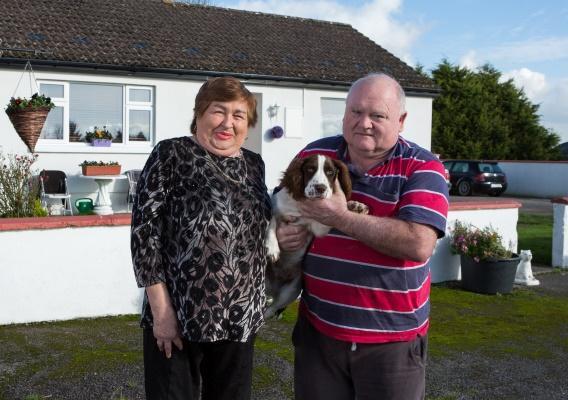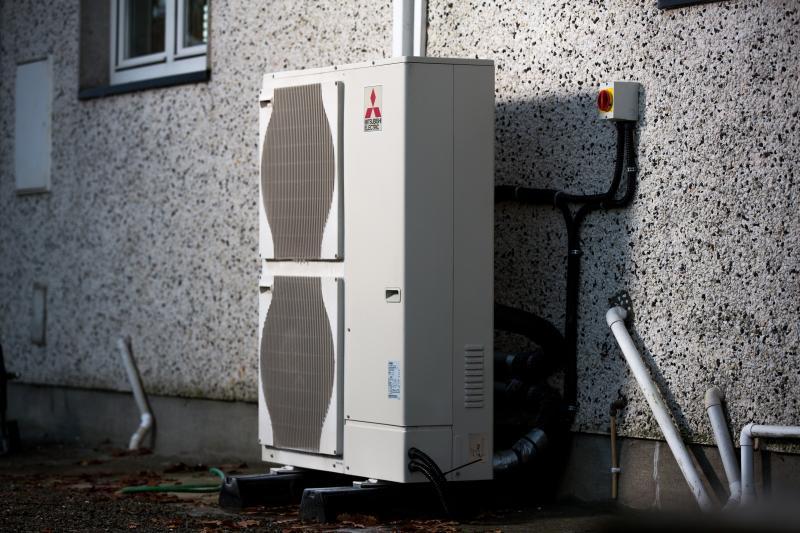Many Irish residences are heated with dirty coal fireplaces. The ELENA programme brings Tipperary energy efficiency and clean homes
Aileen McCarthy had a dirty and difficult winter morning routine.
After waking up in her cold Irish home, she went straight to the fireplace to sweep up burnt coal ashes. After that, she turned on the vacuum to suck coal dust from all the rooms. Then she started a new coal fire, sat down and attached herself to an oxygen tank for most of the day to help her breathe.
“Oh, my god, I can’t describe to you what it was like,” says McCarthy, 59, who lives in the village of Cullen, in the middle of County Tipperary, Ireland. “The ashes and fumes were a constant problem. The air was always congesting me and giving me chest infections.”

Aileen and John McCarthy of Tipperary County, Ireland. Aileen used to start every winter morning by cleaning coal dust from all the rooms.
Opening doors to new energy
Today, McCarthy’s life and health have turned around after a county energy programme removed her coal fireplace and renovated the whole house. Her rooms are now dust free, she can walk around without coughing, and she doesn’t get as many infections. “I don’t know myself today,” says McCarthy, who has a respiratory disease that leaves her with only 20 percent of her lung capacity.
There are many more success stories like McCarthy’s, says Louise White, an energy efficiency expert at the European Investment Bank.
“Energy programmes like this can do more than just save money by lowering bills. They can also really improve people’s living conditions,” says White, who helps run ELENA, the European Local Energy Assistance programme that prepares energy efficiency projects across Europe.
In Ireland, a EUR1.5 million ELENA grant is helping the Tipperary Energy Agency prepare energy audits and feasibility studies that will lead to hundreds of renewable energy renovations in private homes. The grant, signed in July last year, is helping Tipperary install insulation in homes and replace dirty solid-fuel heating systems with modern heat pumps that use electricity. The grant also is helping with the installation of low-energy street lighting and with energy efficiency plans in public buildings and small businesses.
‘We make it as easy as possible’
The EIB hopes that similar energy projects will be started across Ireland. One of the main aims is to build up local knowledge and then use the new capability to replicate the project. An ELENA grant in the Picardy region of northern France, for the renovation of thousands of housing units, is an example of a “one-stop shopping” model that other regions could copy. In Ljubljana, Slovenia, local officials used ELENA to make sweeping energy renovations, and the government published guidelines to show others how to replicate the city’s energy efficiency plan.
ELENA is growing. In addition to other energy projects being supported, the European Commission decided late last year to allocate EUR 94 million to ELENA to expand energy efficiency in the European residential sector. The EIB runs the ELENA programme on behalf of the European Commission.
“ELENA offers that extra something that can get energy projects started, even in private homes,” White says.

Aileen McCarthy closed up her coal-burning fireplace and installed this energy-efficient heat pump that runs on electricity.
More money for efficiency
In the past, ELENA mainly helped local and regional municipalities renovate public structures. With the new funds, ELENA will serve banks, housing development agencies, homeowner associations, energy agencies and other bodies that manage residential projects.
The Tipperary programme is an example of the residential projects ELENA will replicate with the new money. In Ireland, there is a big need for home energy renovations. Across the country, many older homes lack insulation and are heated with open fireplaces and stoves that burn coal and wood. McCarthy says most neighbours in Cullen heat their homes with coal in open fireplaces.
“We’re are doing more and more deep retrofits of homes,” says Paul Kenny, chief executive of the Tipperary Energy Agency. “The work is drastically improving the air quality by removing solid-fuel fireplaces and stoves and eliminating combustibles.”
McCarthy’s residence was turned into what Kenny refers to as a “superhome.” Such a home has:
- good insulation and thick windows
- advanced ventilation
- no open fireplaces
- heat and hot water provided by renewable energy such as solar panels or heat pumps.
McCarthy is saving about EUR175 a month in energy costs after the renovations. She also isn’t sick as often.
“This time last year, I was in the hospital with a chest infection,” she says. “My health was so bad I could barely walk to the bedroom without my oxygen tank. Now, I don’t need the oxygen as much and I barely see the doctor.”
